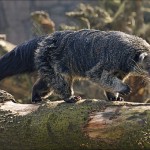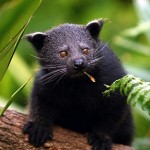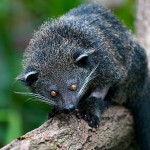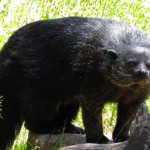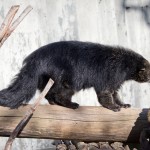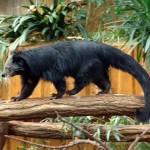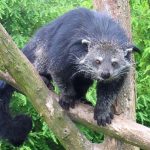The Binturong is an exotic species which is indigenous to the dense tropical jungles of South East Asia. Although they were earlier in abundance, their numbers have started declining and they are classified as a vulnerable species today. The binturong is a large, exotic carnivore, nearly a meter tall, with a slow, heavy, and sluggish appearance.
They have a thick and coarse coat of fur and resemble other civets such as mongooses. Also known as a bearcat, there are over nine different types of the species which are all alike in appearance, but vary in terms of their height and weight. Despite being carnivores, Binturongs primarily eat fruits and are good at climbing trees. However, they also hunt small rodents, birds and some insects at night time.
Facts :
The increasing use of Binturongs as pets, attractions in zoos and its use as food and medicine have led to a decline in the population of the species. It is now classified as a vulnerable or threatened species and there has also been a significant amount of damage done to its natural habitat in South East Asia.
Diet :
Binturongs, despite being carnivorous animals, eat fruits as a primary diet. They go about hunting for prey in their natural habitat, often consisting of small rodents, birds and insects. It is recommended to offer a binturong as natural a diet as possible, allowing it to pluck its own fruit or stalk its own insects.
Habitat :
Bints were natively located around Laos, Thailand, China, Philippines, Indonesia, Borneo island, India and Cambodia. However, it's important to note that despite the large number of binturongs recorded in these areas, their population has significantly declined over the years.
Currently, Binturongs are very difficult to spot due to their huge population loss and they belong to vulnerable species on the brink of extinction.
They are mostly found in dense jungles that are located near slow-moving water bodies. Due to habitat loss in most Southern parts of its natural habitat, the population of Bints has drastically reduced.
In areas without high cases of deforestation, Bints have been affected mostly by hunting carried out by the ever-increasing human population.
Interestingly, Bints thrive on thick and dense forests with cover on the ground and on trees. With massive deforestation, Bints have fewer places to go.
Behavior :
A Binturong is a carnivorous animal that typically belongs to the tropical jungles. While they are not aggressive in nature, they have the instincts of being a carnivore and can prove to cause harm to humans.
However, they can enjoy time with humans, given there is not too much chaos around. Binturongs are tropical animals and they do not do well in cold climates.
In fact, the natural habitat of a Binturong is that of a warm and moist tropical jungle and if these conditions are not met, the animal may prove to regress and go into withdrawal, spending most of the time sleeping.
Lifestyle :
Binturongs, despite being carnivores, are mostly gentle in nature. They survive on a fruit diet and only sometimes resort to eating animals and birds. They are somewhat solitary animals and prefer being away from other animals.
In fact, a Binturong is highly agoraphobic and also dislikes wide and open spaces. It sticks to walls and canopies whenever it is presented with the option of doing so.
Often spotted in zoos and in recreational centers, Binturongs can enjoy playful moments and quiet time on their own, given that there is not too much chaos or confusion going on around them.
Lifecycle :
There is no specified mating season for Binturongs but there are higher incidences of mating between February and April and also July and November.
Their gestation period is 3 months. Before this, female binturongs build nests in dense vegetation to protect them from predators and the elements.
Female Bints are capable of producing between 1 and 3 cubs at once. These cubs measure exactly as human fists. They are blind and deaf at birth with full dependence on their mothers for milk.
At the age of 2 months, they are weaned and they attain the status of adulthood after one year. In their wild form, they live between 10 and 15 years but when they are in captivity, they tend to live longer. Bints can live for 25 years under captivity.
Predators :
Humans are the primary predators of Bints. They go directly to their habitats and hunt Bints. They are credited for the massive depletion in the population of Bints around the world.
Breeding :
In captivity, Bints are mostly found in zoos. Zoos and games reserves are the best places you can breed Bints because a similar dense tropical habitat can be obtained there.
However, they are well known for their high degree of intelligence and curiosity. Also, their temperament makes them difficult pets and you are advised not to train them at home unless you are a trained wildlife handler.
Appearance :
The Binturong is an exotic, large and bulky animal, which resembles a mongoose or the civet family of carnivores. It is heavy and sluggish in its movements and has round and brown eyes, with long white whiskers on the cheeks.
The fur of the Binturong is coarse and it also uses its tail for stabilizing itself. An adult Binturong rages from 60 – 96 cm in length. The weight of a Binturong may lie in between 10 – 14 kg.
The binturong has long hairs in its coat, which gives off the appearance of shaggy and coarse fur. The color of the coat may vary from black to dark brown in color and is often streaked with grey.
Tufts of straight and long hair also protrude out of the top of the ears. The Binturong is a bulky, large and rather heavy animal. It is sluggish and slow moving, but is excellent at climbing trees.
It is also a carnivore and despite slow speeds, it can efficiently hunt smaller rodents, small birds and insects with ease.
Life Span :
Generally, Bints tend to live longer when they are in captivity. They can live for up to 25 years in captivity depending on the care they receive from their host. However in their wild form, Bints tend to live for 10 – 15 years.
Health Issues :
Bints suffer from Canine distemper virus. Effects of this infection include:
- Red or tan colored lungs.
- Congestion of small intestine and stomach.
- Interstitial pneumonia.
- Suppurative bronchopneumonia.
- Diffuse hyperkeratosis on their foot pads.
It is caused by aparamyxovirus that resembles the virus that causes rinderpest and measles. It is spread through aerosol droplets by infected animals. To prevent this disease in our binturongs, it is recommended to take measures to avoid its occurrence.
This is because no treatment pattern has proved to be uniformly successful. Prevention of canine distemper virus is through vaccination.
Grooming :
Generally, Binturongs groom themselves by chewing, scratching, cleaning and licking themselves with their hind paws. As a breeder however, you are expected to brush their hairs occasionally and also whenever they shed their pelage to prevent skin diseases.
Shedding :
As with other animals that possess hair, binturongs shed their pelage periodically. However, whenever they fall sick they shed their pelage uncontrollably. Ensure that you brush off the shed pelage to prevent skin diseases.
Binturong Characteristics :
- They are large and tall carnivores.
- It is a vulnerable species.
- They are carnivores but they eat fruits as their primary diet.
- Generally, Binturongs prefer to live in tall forests.
- They are not aggressive in nature.
- Binturongs dislike open places.
- They are born blind after gestation of 3 months.
- Humans are their primary predators.
- They can only thrive in dense jungles.
- Binturongs are large and bulky. They look like mongooses.
- In their wild form, they live for 10 – 15 years while in captivity, they can live for 25 years.
- Bints generally suffer from canine distemper virus infection.
- Just like cats, they groom their coats.
- They shed their coats when they suffer from diseases.
Images, Pics, Photos and Pictures of Binturong :
Binturong Information :
- Their common name is Arctictis Binturong.
- They are also called Palawan Bearcat, Asian Bearcat and Asian Civet.
- They originate from South East Asia.
- Binturongs are medium-sized carnivores.
- They belong to the Non-sporting civet breed group.
- The live for approximately 10 – 25 years.
- Their heights range from 60 – 96 cm.
- Binturongs appear in colors like black, grey and brown.
- The average price of Binturong between $1000 and $2000.
- Generally, they sleep for an average time of 12 hours daily.
- Lower classifications of Binturongs include Civets, Fossa, Mongooses and Genets.

